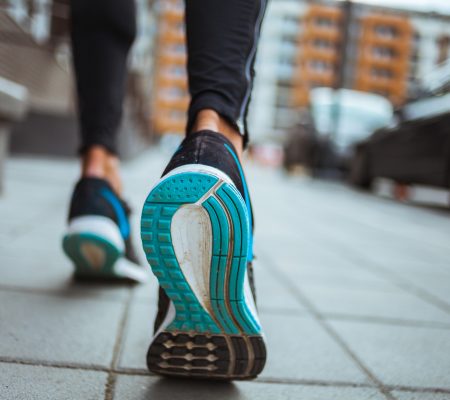Understanding Orthotics: How the Right Footwear Prevents Injury and Promotes Proper Body Mechanics
The right footwear prevents injury and reduces pain… but chances are, you already know that. Anyone who’s tried to walk even a few blocks in bad shoes has experienced the agony of the wrong footwear choice.
Similarly, you’ve probably heard of orthotics—insoles that go into your shoes to increase comfort and support. But understanding orthotics and their importance may require exploration: how do orthotics work and who should wear them? Are custom orthotics worth the investment? What about over-the-counter orthotics? Do they really make shoes more comfortable?
The crucial component of foot comfort is wearing the right shoes for your feet. Proper footwear can include a pair of orthotics for added stability, but the real key is choosing the right footwear for injury prevention, suited to the task at hand (or at foot, rather).
Two of Orthopaedic Hospital of Wisconsin’s experienced physical therapists, Crystal Toll and Melissa Post, provide their expert opinions on how to choose the best pair of athletic shoes for your body. They also explain how to get fitted for the proper orthotics, should you need them, and what benefits orthotics can offer.
Determining What Athletic Shoes are Right for You
Runners and athletes often ask Crystal Toll, PT, MPT, CSCS, CMTPT about footwear. Patients want her opinion on which shoes are best for their mileage and their physical activity. With dozens of brands and even more styles of athletic shoes to choose from, how do runners pick the right one?
their mileage and their physical activity. With dozens of brands and even more styles of athletic shoes to choose from, how do runners pick the right one?
Toll explains, “Running shoes are generally divided into three categories to match foot posture: neutral/cushioning, stability and motion control. I have often seen people wearing a shoe that is old and worn down, or simply is not the right style for them. Addressing these errors is critical in improving comfort.”
To figure out the right shoes for injury prevention, runners need to know what type of foot they have—how does your foot hit the pavement? You can tell a lot about your feet with a simple footprint test. Wet your foot with water, and then step on a piece of cardboard. Examine your footprint for a better understanding of your arch.
- Normal Arch: The middle part of the arch is about half-filled. The right shoes for this type of foot are in the stability category.
- Flat Arch: The footprint looks like a complete foot—no or very little arch. Feet with a flat arch often roll in or pronate during activities. For flat arches, look for shoes in the motion control category.
- High Arch: Seeing only a thin portion on the side of your footprint indicates a high arch. This type of foot may not absorb shock as well as other types. Look for shoes in the cushioning category.
The other key to selecting the right athletic shoes for injury prevention is to get professional advice. Consider working with the staff at a running shoe store. These employees work with runners, walkers, and fitness enthusiasts to help find the shoes that work best. Toll adds, “Plan to spend at least 30-45 minutes at the running shoe store—this will give you plenty of time to try on a variety of shoes. Many running shoe stores even have a treadmill available to assist with picking out your next pair.”
The running shoe industry has made excellent advancements. Often, all you need for comfortable running and injury prevention is a shoe that matches your foot type. The right shoes help you feel comfortable mile after mile.
Understanding Orthotics and the Right Option for Your Foot
Of course, there are times when athletes of any type need a more customized fit. By adding orthotic support into your footwear, you improve comfort with standing, walking, or running. Orthotics prevent injury by encouraging your body to move properly and provide extra cushion in all the right places.
So, how do you figure out when you need proper orthotics? Check with someone who has a strong understanding of orthotics, like a physical therapist. Physical therapists can help you determine the right fit and level of stability for your footwear. A professional assessment is especially crucial if you have foot, leg, or even back pain—an insert, or orthotic, might be just the thing your foot needs to hit the ground with ease.
Melissa Post PT, DPT, TPS, says, “If you want to be the fastest runner in Wauwatosa, you have to start with a stable base!” Orthotics can  provide cushion, shock absorption, and support above the level of what is already in a pair of shoes.
provide cushion, shock absorption, and support above the level of what is already in a pair of shoes.
Orthotics help set the foot in a comfortable, more neutral position and place less stress on the lower body. Your physical therapist may recommend different levels of customization, depending on why the orthotic is needed. They’re great at helping people with foot pain decide which orthotic style would be most appropriate, as they can assess the person’s needs with specific tests.
When it comes to selecting orthotics, you have three options: over-the-counter, semi-custom, and custom orthotics. Here is the breakdown to help you with understanding orthotics and choosing the right option for injury prevention.
Over-the-Counter Orthotics
Over-the-counter orthotics are a basic jump-off point for those new to orthotic options. These inserts add support to the foot and ankle inside a shoe. Over-the-counter orthotics’ quality dramatically varies, and the store-bought inserts aren’t always specific enough to address a person’s needs. For example, there is a wide range of thicknesses and support levels in this category. The type and quality of materials used to make over-the-counter orthotics vary widely as well.
The best uses for over-the-counter orthotics are basic support for low arch feet and generalized cushioning for high arch feet. Some product lines even offer different levels of arch support, sports models, or dress models. This type of orthotic is useful for those who want something immediate at a lower cost. They may also help turn an uncomfortable pair of dress shoes into a better fit.
Semi-Custom Orthotics
Semi-custom orthotics allow your therapist to make modifications to fit your needs. With semi-custom orthotics, the therapist takes a basic insert and uses a heat gun to mold layers to the bottom to add stability based on their evaluation of a person’s foot structure.
The benefits of semi-custom orthotics include more individualized support and lower cost compared to custom orthotics. Semi-custom options are often fit and issued on the same day, making them convenient as well. These orthotics offer options in thickness and type of material, which allow the orthotic to fit different types of shoes. Some styles provide other options depending on the person’s weight or activity level, enabling you to see changes to foot/ankle stability and comfort in real-time.
The limitations of semi-custom orthotics are due to the semi-customizable aspect. There are fewer options in the type of materials and less durability than custom orthotics.
Custom Orthotics
Custom orthotics are the top-of-the-line and the most personalized orthotic option. In some cases, medical doctors even prescribe them. Custom orthotics can help treat arthritis, bunions, diabetic feet, flat arch feet, fibroma, high arch feet, neuroma, forefoot varus/valgus, stiffness/pain in the toes/feet, plantar fasciitis, tendonitis, and other foot-related concerns.
Because the therapist makes custom orthotics from a mold of each foot, they ensure the orthotic is the best possible fit for the person’s needs. After creating the mold, the therapist decides on the types of materials, amount of arch support, thickness, and other features, based on their assessment of the feet.
Custom orthotics allow for better correction of mechanical foot issues and can even be used to reduce foot friction against shoes. They’re typically made from durable, long-lasting materials. Limitations include overall cost and wait time for delivery, which can take several weeks.
Wearing the right footwear helps prevent injury and encourage proper body mechanics. Proper footwear, especially when you combine it with the right orthotics, will help prevent ankle sprains and provide support while building strength, proprioception, range of motion, and balance. The addition of orthotics to your footwear will help you compensate for existing conditions or correct faulty running mechanics so you can keep moving comfortably. Speak with a physical therapist today to gain an understanding of orthotic options and learn what footwear options are best for you.


